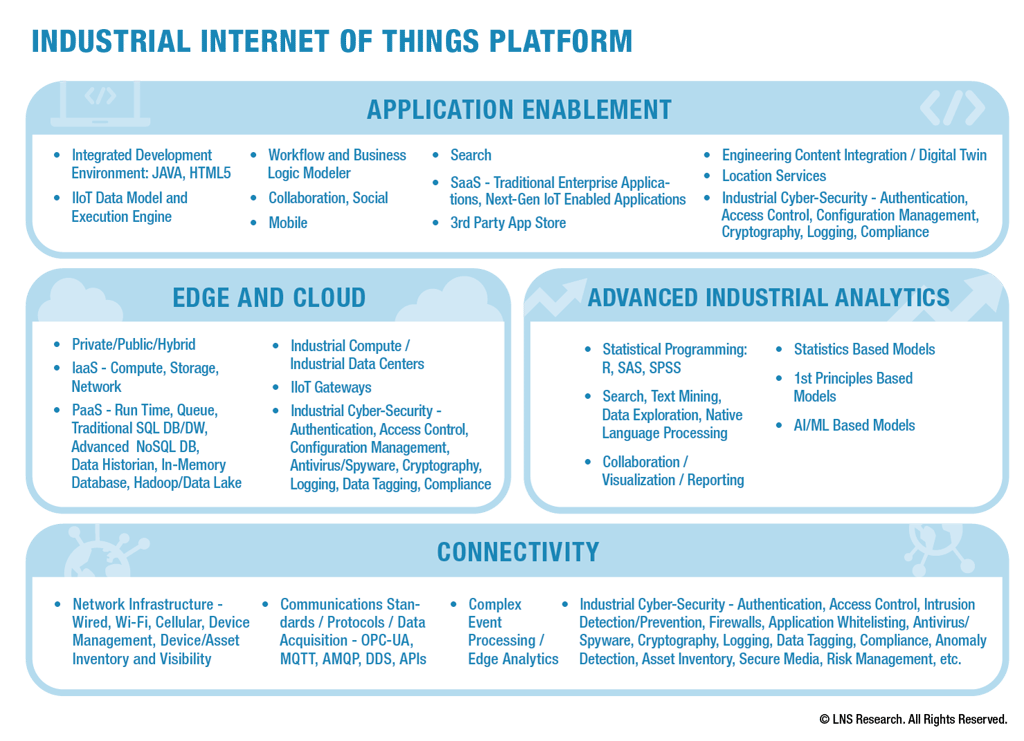In November 2014 Michael Porter and Jim Heppelmann published their seminal piece on Smart Connected Products in Harvard Business Review (HBR), and presented a framework for understanding both the technology stack supporting these products and how these new product architectures will transform industries and competition.
.
Earlier this month the duo teamed up to publish a follow on HBR article examining how Smart Connected Products will transform companies internally. As LNS Research has been very focused on researching how the Industrial Internet of Things (IIoT) is enabling Operational Excellence and Industrial Transformation; in this post we will examine the concepts put forth in this new article and provide our perspective on Smart Connected Operations and Smart Connected Assets.
Next Generation Technology Stack
One of the first topics covered in the article is the Technology Stack needed to enable Smart Connected Products. In this view of the world, the technology stack will include:
- Identity and Security
- Product Cloud
- Connectivity
- Physical Product
- External Information
- Integration with Business Systems
Porter and Heppelmann further argue that this entirely new infrastructure will be needed, and the architecture will involve multiple layers along with hardware and software.
LNS Research agrees with much of this, and has been promoting the concept of the need for a new IIoT platform to be deployed in manufacturing.
Some important points to know about the IIoT Platform include:
- The IIoT platform will enable both next-generation business applications, as well as the re-platforming and splitting up into component functionalities of existing applications
- It will include a combination of hardware and software, as well as traditional IT and OT capabilities
- Security needs to be imbedded at every layer of the architecture
- Today it takes an ecosystem of vendors to provide the full platform
Big Data Analytics
Another topic highlighted in the article was the concept of Big Data Analytics. The authors stress the important of new data sources coming from 1000s of sensors deployed across products and operations and the opportunity this presents in manufacturing to enable more predictive analytics in areas like maintenance.
LNS Research has written broadly on the topic of Big Data Analytics in manufacturing and for most manufacturers they have a lot of data, but not Big Data. The challenge in manufacturing is not data volume, but data velocity and data variety. More work still needs to be done in enabling high speed data transports, being able to handle data types with a schema that is quickly adaptable; and can enable analysis across existing structured data from applications, semi-structured data coming from data historians, and un-structured data coming from machine, web, multi-media, and geospatial data.
Business Model Transformation
One of the most exciting areas of the IIoT is enabling new business models. The authors clearly articulate how service-based industries are being transformed by Smart Connected Products and enabling the move to “power-by-the-hour” models. Both LNS and the authors believe this trend is only going be increase over time, especially in areas like industrial equipment manufacturing and even in places that traditionally weren’t services heavy. Early examples of this include industrial printing, compressed air, lifting equipment, and more. In all of these cases LNS Research believes the move to these new business models will be enabled by internal technology architectures like the Digital Thread and Smart Connected Assets; where the assets are aware of and can react in an autonomous way to engineering data, operational data, environmental data, customer data, supplier data, and more.
Transforming Manufacturing Operations
Much of the hype around initiatives like Smart Manufacturing and Industrie 4.0 has been centered on transforming the factory and operations within. Although much of the previous discussion from the authors has been focused on the product, this new article introduces the idea that the same underlying technologies that are transforming products can also be applied to transforming operations.
LNS Research believes that the IIoT platform technologies discussed above will extend much of the good work already being done in digital manufacturing and integrating systems like PLM, ERP, MOM, and Automation. The IIoT platform technologies will also transform the traditional manufacturing system architecture from one that is exclusively hierarchical to one that better incorporates the flow of information across the value chain, and also enables next-generation applications that spans the value chain, like flexible manufacturing, energy optimization, and traceability.
Organizations Structure
One of the final points made in the article was that the organizational structure of manufacturing organizations will have to change to address and capitalize on these new realities. Some of the predictions made in the article include the creation of a Chief Data Officer and the creation of new cross functional teams that are focused on areas like product development and customer success.
LNS Research whole heartedly agrees that change in this area is necessary and believes that a number of organizational changes will have to happen in manufacturing for success to be achieved in these areas, including:
- Create Manufacturing/Automation/IT cross functional teams or Manufacturing Systems groups to enable IT-OT convergence and manage system architecture
- Develop IT leaders that are more business savvy and Operational leaders that are more IT savvy
- A new training and development initiative that extends existing 6 Sigma and Operational Excellence initiatives to increase the data science skill set
Much of the technological lead in IoT related topics has been taken by large IT and service companies. LNS research is excited to see manufacturing focused companies like PTC working with industry thought leaders and other companies to move beyond just engineering and products to think about how technologies like the IIoT will also transform operations.
Gain a year of free access to new research in our IoT Research Library by completing a survey.